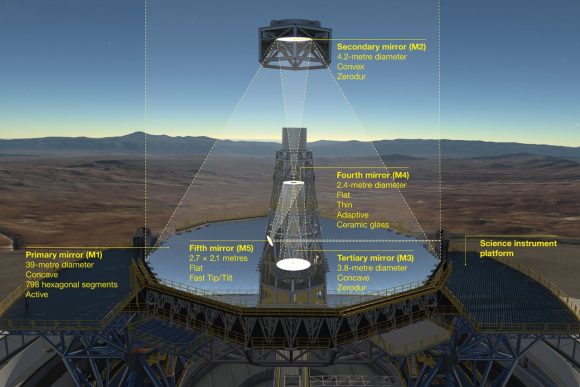We humans have an insatiable hunger to understand the Universe. As Carl Sagan said, “Understanding is Ecstasy.” But to understand the Universe, we need better and better ways to observe it. And that means one thing: big, huge, enormous telescopes.
In this series we’ll look at 6 of the world’s Super Telescopes:
- The Giant Magellan Telescope
- The Overwhelmingly Large Telescope
- The 30 Meter Telescope
- The European Extremely Large Telescope
- The Large Synoptic Survey Telescope
- The James Webb Space Telescope
- The Wide Field Infrared Survey Telescope
The European Extremely Large Telescope
The European Extremely Large Telescope (E-ELT) is an enormous ‘scope being built by the European Southern Observatory. It’s under construction right now in the high-altitude Atacama Desert of northern Chile. The ESO, with its partners, has built some of the largest and most technically advanced telescopes in the world, like the Atacama Large Millimeter Array (ALMA) and the Very Large Telescope (VLT.) But with a 39 meter primary mirror, the E-ELT will dwarf the other telescopes in the ESO’s fleet.
As Dr Michele Cirasuolo, Programme Scientist for the ELT told Universe Today, “The Extremely Large Telescope (ELT) is the flagship project of the European Southern Observatory (ESO), and when completed in 2024 will be the largest optical/infrared telescope in the world. It represents the next step forward and it will complement the research done with the GMT (Giant Magellan Telescope) and other large telescopes being built.”

The E-ELT is the successor to the Overwhelmingly Large Telescope (OWL), which was the ESO backed away from due to its €1.5 billion price tag. Instead, the ESO focussed on the E-ELT. The site for the E-ELT was selected in 2010, and over the next couple years the design was finalized.
Like other telescopes—including the Keck Telescope—the E-ELT’s primary mirror will be made up of individually manufactured hexagonal segments; 798 of them. The primary mirror will be fitted with edge sensors to ensure that each segment of the mirror is corrected in relation to its neighbours as the scope is aimed or moved, or as it is disturbed by temperature changes, wind, or vibrations.
The E-ELT is actually a 5 mirror system. Along with the enormous primary mirror, and the secondary mirror, there are three other mirrors. An unusual aspect of the E-ELT’s design is its tertiary mirror. This tertiary mirror will give the E-ELT better image quality over a larger field of view than a primary and secondary mirror can.
The ‘scope also has two other mirrors which provide adaptive optics and image stabilization, as well as allowing more large science instruments to be mounted to the ‘scope simultaneously.

The Science: What Will the E-ELT Study?
The E-ELT is designed for an ambitious science agenda. One of the most exciting aspects of the E-ELT is its potential to capture images of extra-solar planets. The 39 meter mirror will not only collect more light from distant, faint objects, but will provide an increase in angular resolution. This means that the telescope will be capable of distinguishing objects that are close together.
As Dr. Cirasuolo explains, “This will allow the ELT to image exoplanets nearer to the star they are orbiting. We aim to probe planets in the so called habitable zone (where liquid water could exist on their surfaces) and take spectra to analyse the composition of their atmospheres.”
The E-ELT has other goals as well. It aims to probe the formation and evolution of planetary systems, and to detect water and organic molecules in protoplanetary disks around stars as they form. It will look at some of the most distant objects possible—the first stars, galaxies, and black holes—to try to understand the relationships between them.
The telescope is also designed to study the first galaxies, and to chart their evolution over time. As if this list of science goals isn’t impressive enough, the E-ELT holds out the hope of directly measuring the acceleration in the expansion of the Universe.
This video explains the design of the E-ELT and some of its science goals.
These are all fascinating goals, but for many of us the most compelling question we face is “Are We Alone?” Dr. Cirasuolo feels the same. As he told Universe Today, “The ultimate goal is finding signs of life. Certainly the next generation of telescopes will provide a huge leap forward in our understanding of extra solar planets and for the search for life in the Universe.”
The E-ELT won’t be working alone. Other Super Telescopes, like the Giant Magellan Telescope, the Thirty Meter Telescope, and even the Large Synoptic Survey Telescope, will all be working in conjunction to expand the frontier of knowledge.
It may be a very long time, if ever, before we find life somewhere else in the Universe. But by expanding our knowledge of exo-planets, the E-ELT is going to be a huge part of the ongoing effort. A few years ago, we weren’t even certain that we would find many planets around other stars. Now the discovery of exoplanets is almost commonplace. If the E-ELT lives up to its promise, then capturing actual images of exoplanets may become commonplace as well.


Keep them coming! Great series.
Loving this series of articles! Can’t wait for the rest!